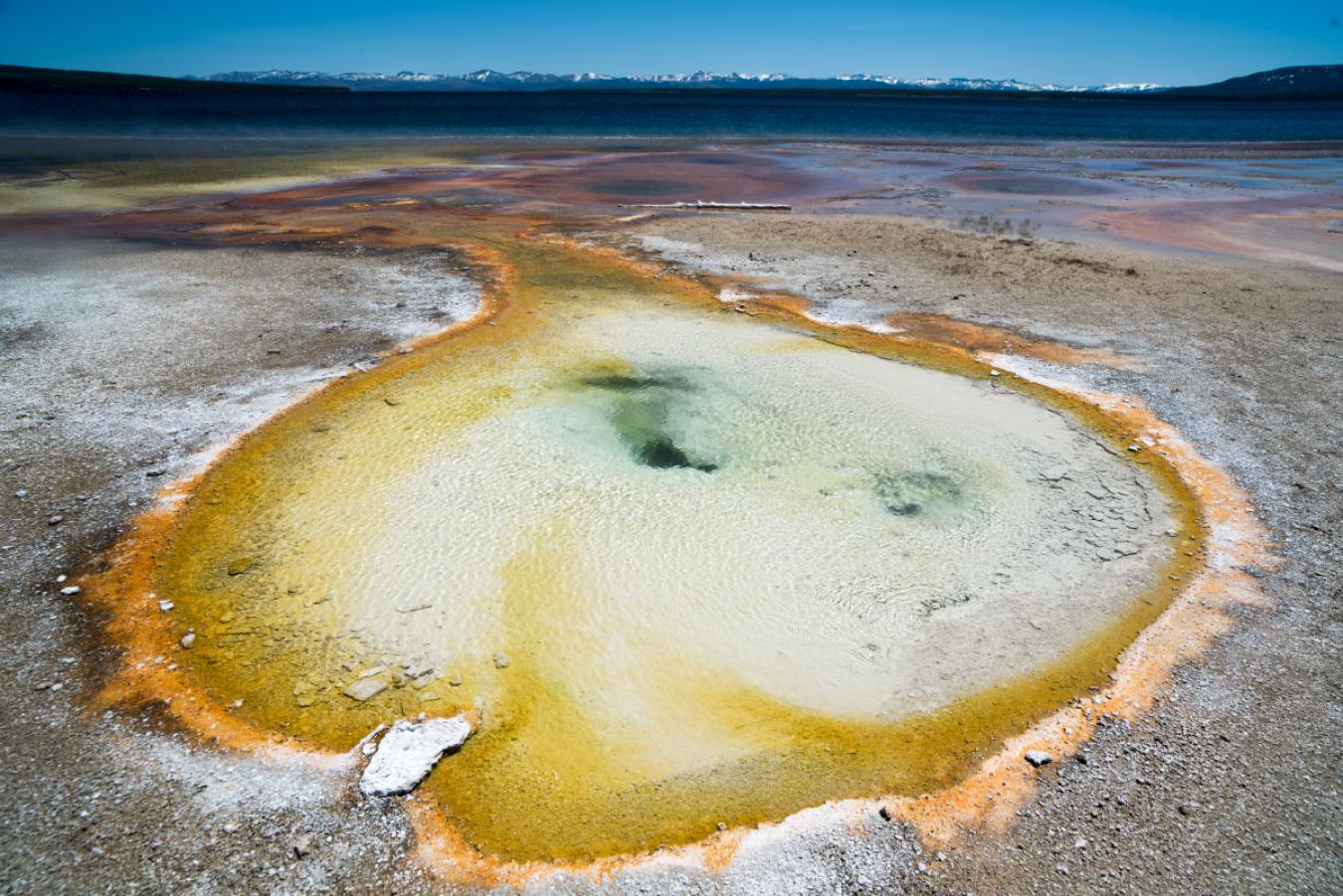To understand what determines microbial diversity, scientists studied microbes in hot springs at three different locations around the world.
February 27, 2025Shannon Brescher Shea

Shannon Brescher Shea (shannon.shea@science.doe.gov) is the social media manager and senior writer/editor in the Office of Science’s Office of Communications and Public Affairs. She writes and curates content for the Office of Science’s Twitter and LinkedIn accounts as well as contributes to the Department of Energy’s overall social media accounts. In addition, she writes and edits feature stories covering the Office of Science’s discovery research and manages the Science Public Outreach Community (SPOC). Previously, she was a communications specialist in the Vehicle Technologies Office in the Office of Energy Efficiency and Renewable Energy. She began at the Energy Department in 2008 as a Presidential Management Fellow. In her free time, she enjoys bicycling, gardening, writing, volunteering, and parenting two awesome kids.
Boiling hot water bubbles up into pools of vibrant teal and blue. The steam rises, burning anyone who gets too close. The water is acidic – sometimes as acidic as stomach acid. Yet you’re fine, having evolved to live in such extreme circumstances. This is the life of a microbe in a hot spring in Yellowstone National Park.
To understand the communities these strange lifeforms create, researchers from the Department of Energy’s Oak Ridge National Laboratory catalogued microbes living in hot springs in Yellowstone, Iceland, and Japan.
They go to extremes
Creatures who live in such challenging environments are called extremophiles. Studying extremophile microbes – especially those that live in hydrothermal systems like hot springs – can provide insights not available elsewhere. It’s likely that hot springs have been around since the planet’s very early history. They may have even been where some of the earliest forms of life evolved. Today, they host diverse and vibrant communities of microscopic organisms. Studying the microbes that live in these locations can help scientists understand both their importance in current ecosystems and the evolution of life on Earth.
In addition, these microbes’ unique characteristics can lead to unexpected discoveries. In 1964, Indiana University professor Tom Brock was one of the first people to investigate if anything lived in the Yellowstone hot springs. His team froze and grew a number of different bacteria. They also sent live samples to a biological collection. One of these bacteria - Thermus aquaticus – was essential to researchers when they were searching for an enzyme that could withstand boiling. It ended up being fundamental to the PCR method of analyzing DNA. This method is used across a huge number of areas in medical and biological applications.
Why do they live where they live?
Currently, one of the big scientific questions about microbes in hot springs is “What determines which microbes are in which hot springs?” Because hot springs exist on every continent, it would make sense that there would be a large variety of microbes.
Types of hot springs can vary quite a bit from each other. These systems can result from volcanic activity fed by magma or simply very hot rocks. The water that feeds the springs can run through several different types of rocks. Basalt is one common bedrock. It’s a volcanic (igneous) rock resulting from cooled lava with a low amount of silica. It’s often black or dark grey and used in floor tiles or cobblestones. Rhyolite is another volcanic rock, but one with a lot of silica. It tends to be a much wider variety of colors and is composed mainly of quartz. Andesitic bedrock has characteristics that are between the two. The springs in Iceland are mainly basalt bedrock, the ones they sampled in Japan are mainly andesitic, and the ones in Yellowstone are mainly rhyolite. Because these types of bedrock have different mineral makeups, they all have different characteristics and effects on the springs’ chemistry.
Despite differences in water chemistry, the types of microbes at different sites are surprisingly similar. Scientists have two hypotheses as to why. The first is that pH (the level of acidity of the water) is the main driver of what microbes are present. Temperature is a second important influence. Along this line of thinking, if all hot springs had the same pH and temperature, they would have similar microbes, regardless of how far away the springs are from each other. The variety comes from some microbes being better adapted than others to the very specific conditions they live in. The other hypothesis is that geographic separation is the main driver of differences in microbial communities. Even if all of the hot springs had similar conditions, the microbial communities would be different.
Getting down and dirty
To investigate which of these hypotheses are most likely to be true, researchers from DOE’s Oak Ridge National Laboratory set out to compare microbes from hot springs in three different continents. It was the first time that scientists had compared microbes in hydrothermal systems with such radically different characteristics. Researchers sampled from 25 different springs in Yellowstone, 28 in Iceland, and 5 in Japan.
All three sites didn’t have any microbes that perform photosynthesis. The environmental conditions are simply too harsh. As a result, all of the microbes must rely on chemical energy instead of the sun.
The springs varied in pH from 2 (similar to vinegar) to 10 (more alkaline than if you mixed baking soda into water). The differences in pH happen because some of the gases underground interact with the liquids and the rocks. When hot vapors with certain gases come up from the ground, they condense and combine with the water to form sulfuric acid! Pretty nasty stuff. The scientists found that the most acidic springs had the least diversity, while the mildly acidic ones had the most.
Similarly, the hotter the temperature, the less diversity there is. While all of the microbes can withstand harsh conditions, only certain microbes are tough enough for the most extreme environments.
Examining pH, temperature, and the microbes, the researchers teased out their relationships. pH seemed to be the main driver of the composition of the microbial communities. The presence of certain chemicals in the water due to the types of bedrock and gases was a secondary factor, with temperature coming in third.
Across all three areas, they found a lot of variety of microbes but also similarities. Only nine microbial groups were abundant in more than one region. But those groups are major players in the microbial world. In this study, they were abundant in multiple springs in multiple regions. They’re also pretty common in other hot springs around the world. The microbes seem to be able to spread over vast distances. The environmental conditions winnow the microbes down to whichever ones do the best in that space.
Exploring the complex, tiny communities in some of the most challenging conditions on Earth is not easy. But it can provide insights into where we came from and set a foundation for where we could go in our understanding of the Earth around us.



